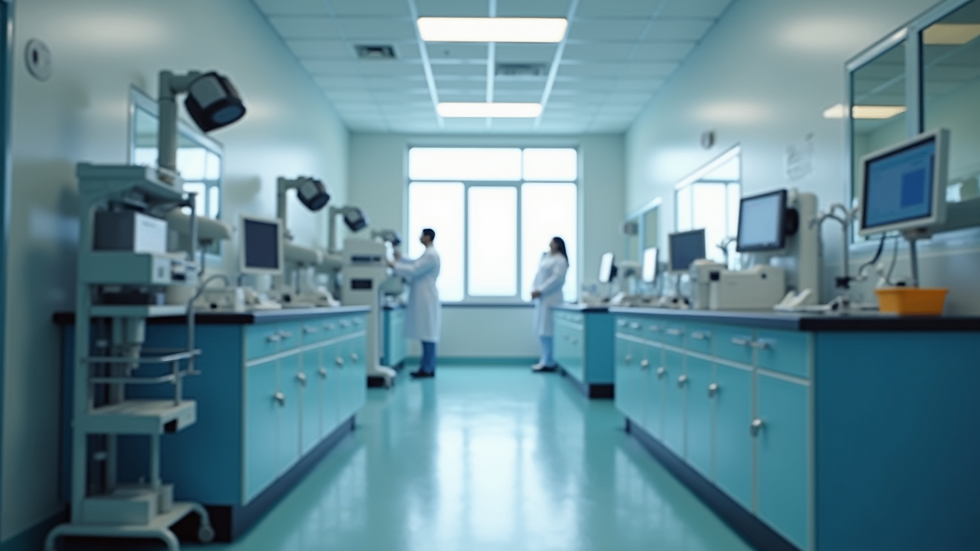Streamlining Pathology Labs with Modern Software
- Alexy Polivany
- Oct 28
- 3 min read
Pathology labs play a crucial role in healthcare by providing accurate diagnostic information that guides patient treatment. However, managing these labs efficiently can be challenging due to the complexity of workflows, data management, and regulatory compliance. Modern pathology tools, especially advanced software solutions, are transforming how labs operate, making processes faster, more accurate, and more reliable.
The Role of Modern Pathology Tools in Lab Efficiency
Modern pathology tools encompass a range of technologies designed to improve lab operations. These include digital imaging systems, automated analyzers, and integrated software platforms that streamline data handling and reporting. By adopting these tools, labs can reduce manual errors, speed up turnaround times, and enhance collaboration among medical professionals.
For example, digital pathology imaging allows pathologists to view high-resolution slides on a computer screen, enabling remote consultations and faster diagnosis. Automated analyzers handle repetitive tasks such as sample preparation and staining, freeing up staff to focus on more complex activities.
Implementing these tools also supports compliance with regulatory standards by maintaining detailed audit trails and ensuring data integrity. This is essential for labs aiming to meet accreditation requirements and deliver consistent quality.

Integrating Software Solutions for Seamless Lab Management
One of the most impactful modern pathology tools is comprehensive software designed specifically for lab management. These platforms integrate various functions such as sample tracking, test ordering, result reporting, and billing into a single system. This integration eliminates the need for multiple disconnected systems, reducing errors and improving workflow efficiency.
For instance, a lab using pathology lab software can automate the entire testing process from sample receipt to report delivery. The software tracks each sample’s status in real-time, alerts staff to pending tasks, and generates reports that can be shared electronically with clinicians. This reduces paperwork, minimizes delays, and enhances communication.
Moreover, such software often includes analytics tools that help labs monitor performance metrics, identify bottlenecks, and optimize resource allocation. This data-driven approach supports continuous improvement and better decision-making.

What is the best lims system?
Laboratory Information Management Systems (LIMS) are a cornerstone of modern pathology labs. The best LIMS system should be user-friendly, customizable, and capable of handling the specific needs of pathology workflows. Key features to look for include:
Sample management: Efficient tracking from collection to disposal.
Data integration: Compatibility with instruments and other software.
Reporting: Automated generation of accurate and compliant reports.
Security: Robust data protection and user access controls.
Scalability: Ability to grow with the lab’s needs.
Popular LIMS options often provide cloud-based solutions, enabling remote access and collaboration. Choosing the right system depends on the lab’s size, budget, and specific requirements. Engaging with vendors for demos and trial periods can help identify the best fit.
Practical Benefits of Automating Pathology Labs
Automation through modern pathology tools offers tangible benefits that improve both lab operations and patient outcomes. Some of these benefits include:
Increased throughput: Automated systems process more samples in less time.
Improved accuracy: Reducing human error enhances diagnostic reliability.
Cost savings: Efficient workflows lower operational expenses.
Enhanced data management: Centralized data storage simplifies retrieval and analysis.
Better compliance: Automated documentation supports regulatory adherence.
For example, automating slide scanning and image analysis can speed up cancer diagnosis, allowing patients to receive timely treatment. Similarly, automated inventory management ensures that reagents and supplies are always available, preventing delays.
Labs that embrace these technologies often report higher staff satisfaction due to reduced repetitive tasks and clearer workflows.
Future Trends in Pathology Lab Technology
The future of pathology labs is closely tied to advancements in artificial intelligence (AI), machine learning, and digital connectivity. AI-powered image analysis is already assisting pathologists by highlighting areas of interest on slides, improving diagnostic accuracy and consistency.
Additionally, telepathology enables remote consultations, expanding access to expert opinions regardless of location. Integration with electronic health records (EHR) systems will further streamline data sharing and patient management.
Wearable sensors and IoT devices may also play a role in continuous monitoring and sample tracking, enhancing lab responsiveness. As these technologies evolve, labs that adopt modern pathology tools will be better positioned to deliver high-quality, efficient services.
Embracing Change for Better Lab Outcomes
Adopting modern pathology tools requires careful planning and training. Labs should:
Assess current workflows to identify pain points.
Choose software and equipment that align with their needs.
Train staff thoroughly to ensure smooth transitions.
Monitor performance and gather feedback for ongoing improvements.
By embracing these changes, pathology labs can enhance their operational efficiency, improve diagnostic accuracy, and ultimately contribute to better patient care.
The integration of advanced technologies and software solutions is no longer optional but essential for labs aiming to stay competitive and deliver excellence in diagnostics.




